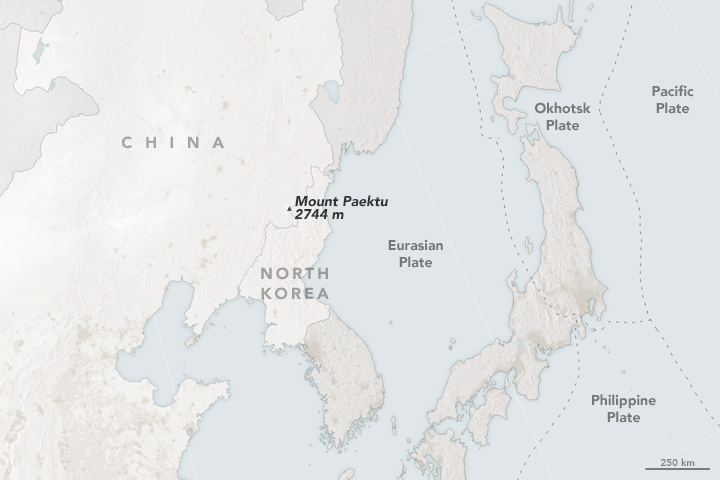Slumbering Giant: North Korea's Mount Paektu volcano seen from space
An image of North Korea's volcano Mount Paektu seen from space has been released by Nasa Earth Observatory. The image of the volcano and surrounding areas was taken in September 2016 with the Operational Land Imager on the Landsat 8 satellite. It shows the caldera, the forests surrounding the 9,000ft mountain and solidified lava to the south-east of Heaven Lake.
North Korea's 'Slumbering Giant' is an active volcano that produced one of the most intense eruptions in recorded history in 946 AD. It is of interest to scientists as sits over 500km from a tectonic plate boundary – where volcanoes are normally found. However, little research has been carried out due to the limited access to the site.
Describing the satellite image, Nasa said: "Forests surrounding the mountain appear dark green. The less-heavily vegetated slopes of the 2,744-meter (9,003-foot) mountain are light green. Heaven Lake sits within the caldera at the top of the mountain.
The grey areas along the south-eastern quadrant are lobes of solidified lava with minimal vegetation. Similar grey lava flows also surround a handful of cinder cones south-east of the caldera."

Mount Paektu appeared to be rumbling to life between 2002 and 2005, when a series of weak earthquakes were recorded around the volcano. This raised concerns it could produce another major eruption, placing the 1.6 million people who living within 100km of the volcano at risk.
As a result, researchers from the UK, US and China collaborated with North Korean scientists to gain a better understanding of the volcano's structure, evolution and history. The first findings from the project were released in April and showed the volcano has molten rock lurking beneath it.
Published in the journal Science Advances, the findings indicated this molten rock could be the source of eruptions over the last few thousand years, and may explain the unrest observed at the start of the 21<sup>st century.
At the time, study author Clive Oppenheimer told IBTimes UK: "The volcano has been active in the historical period and it is safe to assume that at some point in the future – we cannot say when, possibly not for centuries – there will be future activity. It would be the same for many volcanoes that have erupted in the not too distant past, without doing any further work we could conclude that a future eruption is possible."
© Copyright IBTimes 2025. All rights reserved.






















